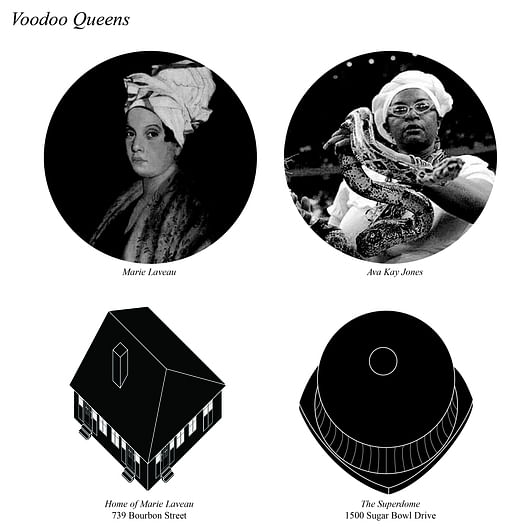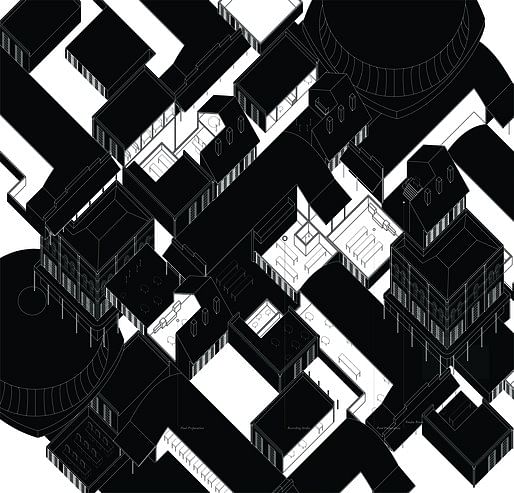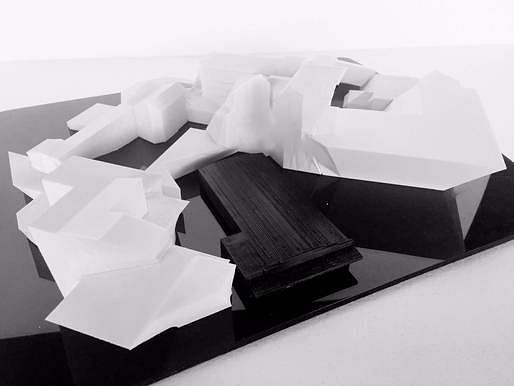
For his project, Colin Lienhard investigated the history/"herstory" of different typologies of 'The Queen' in New Orleans. By mashing up disparate historical and contemporary narratives through axonometric representation, he explored the unique condition for women in New Orleans as how perspectives have changed over time. Stefann Plishka interviews Colin about the challenges of queen-ness in the South and how to design an architecture fit for a queen.
Stefann Plishka: In confronting the "herstory" of New Orleans, you converge the narratives of many different types of women. This resulted in an extraordinary architecture, but one created from ordinary, vernacular architectural elements. What does this say about the legacy of women in the south, particularly in New Orleans?
Colin Lienhard: From the beginning I thought of New Orleans as an atypical situation, probably stemming in part from its origin as a French and Spanish city. For most of its history, the city didn’t have typical sexist conditions as did elsewhere in the South; gay men and women were able to position themselves in society in a unique way, different than the rest of the Southeast region. Drag queens, voodoo queens, and burlesque queens were all part of everyday culture. Now, though, it’s more of a southern town - less open to telling the stories of these unconventional women.
Most of history is a man’s game and doesn’t tell the woman’s story; women preserved culture in their own ways - mostly through a vernacular oral history rather than written. But even though it’s a history not much written about doesn’t mean it didn’t happen.
SP: The "queen" is significantly absent in a culture dominated by "king" cake. How does the legacy of an "under the bridge" condition help her recover?
CL: The site for my project, Big Freedia’s Institute for Iconic Women, is across the Greater New Orleans Bridge on the other side of the Mississippi River. The bridge continues past the site so you have to look hard to find it. To get to the building, you have to reach the end of the bridge and backtrack towards the water. Under the bridge - it’s a space you’re not really supposed to occupy. The world goes on above it without too much consideration; much like women’s history - important but not directly recognized. This location is already where Big Freedia and other Bounce artists perform. It’s a place for celebration, safe to dance and listen to crude, uniquely New Orleans music. Similarly, the world goes on without them. They’re not looking for legitimate recognition, but it’s deserved. Everyone deserves Architecture, even if they can’t afford it. It’s wrong for architects to decide who deserves what. Architecture is a necessity. To deny part of the population a necessity is ridiculous. By compiling and altering buildings from the history of women in New Orleans, I’m gesturing to the vernacular while creating something new. Like Voodoo and Bounce, a space like this could only exist in New Orleans.
SP: Why is the axonometric an architectural representation "fit for a queen"?
CL: To me, the axon is interesting because it claims to show a fairly realistic view of what something should and will look like, but really only shows half of the final architectural expression at a time. Because it shows more than an elevation or section drawing, the axon tricks the viewer into thinking that they understand the whole picture. It’s a drawing that feels fancy. That false confidence that you know what’s going on, but you really don’t at all. It’s interesting - in Revit, the axon is the default view. But using the axon representationally only tells half of the architectural story, which parallels the typical representation of women’s history - it’s only half the story. There’s a whole other side that people just don’t talk about.
Alongside the axonometric drawing that shows the architectural top half, I used worm’s eye drawings to show the architectural backside. The backside architecture is an untold story - again, like the history of women. And the worm’s eye drawing also doesn’t really have a place in typical architecture. Never would you see a worm’s eye in a set of architectural deliverables. Its underutilized, misunderstood, outcast. I wanted to start a conversation about things white men wouldn’t typically look at or talk about in an architectural setting - intellectualizing the primal gesture. By speaking about these issues in an architectural language, you trick people into talking about things they wouldn’t usually be comfortable talking about. By designing an architecture “fit for a queen,” I’m making a place for these women in the city again.






01 Narrative Drawing

02 Narrative Drawing

03 Narrative Drawing

04 Narrative Drawing

05 Narrative Drawing

01 3D Printed Process Model

02 3D Printed Process Model

03 3D Printed Process Model

04 3D Printed Process Model

Site Drawing

01 Worm's Eye

02 Worm's Eye

3D Printed Final Model
Excerpts from "Big Freedia's Institute for Iconic Women"
Colin Lienhard
Masters of Architecture Candidate '15
Georgia Institute of Technology
The second installation of The Dirty South studio with Jennifer Bonner at Georgia Tech takes on New Orleans. Using the legacy of Dirty South hip hop as inspiration within the framework of a guidebook of B-side tours, students investigated unusual patterns and idiosyncrasies in the city. Projects spanned topics from misuse of Charles Moore's Piazza d'Italia to reappropriation of the city's most controversial monuments to installation of an illegal auction house within the convention center.



No Comments
Block this user
Are you sure you want to block this user and hide all related comments throughout the site?
Archinect
This is your first comment on Archinect. Your comment will be visible once approved.